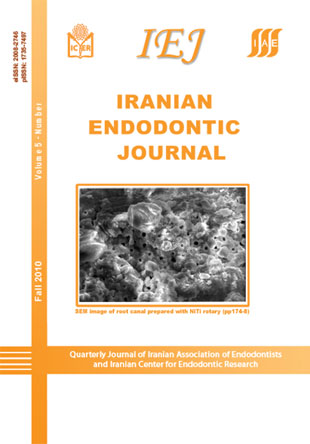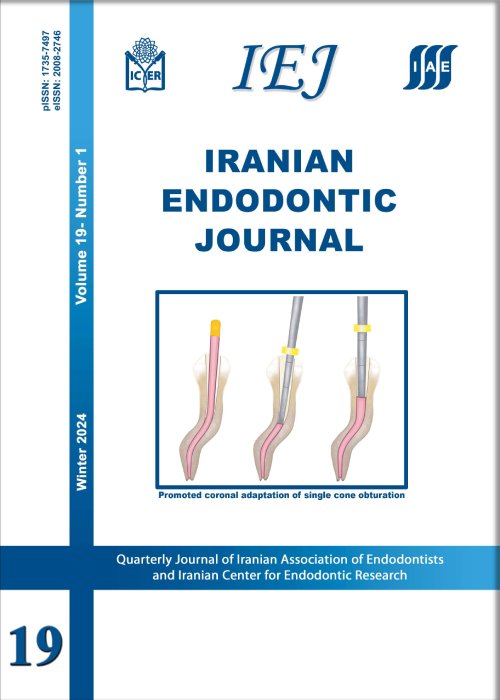فهرست مطالب

Iranian Endodontic Journal
Volume:5 Issue: 3, Summer 2010
- تاریخ انتشار: 1389/07/20
- تعداد عناوین: 10
-
-
Page 97IntroductionGutta-percha is the most commonly used material for root canal obturation; it has been recently manufactured with different tapers. The aim of this in vitro study was to compare microleakage of canals obturated with standard gutta-percha (0.02 taper) or the new 0.04 taper gutta-percha master cone using the cold lateral condensation technique.Materials And MethodsForty-four extracted single rooted teeth were selected. The crowns were removed and all the canals were prepared using Race rotary files. The teeth were then divided into experimental (n=2) and control (n=2) groups. In the first study group, the teeth were obturated with 0.02 taper gutta-percha master cone and lateral condensation. In the second study group, the canals were obturated by 0.04 tapered master cones and the same obturation method. The degree of leakage was measured using fluid filtration method. Data were analyzed statistically by student t-test.ResultsThere was no significant difference between the mean microleakage of two experimental groups (P=0.558).ConclusionLateral condensation technique using 0.04 tapered master cones can provide an effective apical seal similar to 0.02 gutta-percha cones.
-
Page 101IntroductionEffective debridement of the root canal system with chemical irrigants prior to obturation is the key to long-term success of endodontic therapy. The purpose of this study is to compare the antibacterial activity of 2.5% sodium hypochlorite (NaOCl) and 2% iodine potassium iodide (IKI) solutions as intracanal disinfectant in infected root canals during one-visit endodontic treatment procedure.Materials And MethodsThirty single-rooted teeth with necrotic pulps in 27 patients were selected according to specific inclusion/exclusion criteria and divided into two random groups. In group I, canals were irrigated with 2.5% NaOCl during instrumentation and in group II canals were initially irrigated with sterile saline during biomechanical preparation and then exposed to a 5-minute final irrigation with 2% IKI. Bacterial samples were taken before treatment (S1), and at the end of treatment (S2).ResultsBacteria were present in all initial samples. NaOCl was able to significantly reduce the number of colony forming units (CFU) from S1 to S2 in approximately 90 % of canals. Only 15% reductions in CFUs occurred after irrigation/instrumentation in group II; this degree of disinfection was not statistically significant.ConclusionAccording to this study, although root canal irrigation with 2.5% NaOCl could not eradicate all bacteria within the canals; it was significantly superior in comparison with 2% IKI use.
-
Page 107IntroductionThe objective of this study was to compare the shaping ability of three rotary filing systems; constant taper K3 instruments, constant taper ProFile instruments and Progressive taper ProTaper rotary instruments in clear resin blocks with simulated curved root canals.Materials And MethodsForty five resin blocks were divided into three groups. Group A preparation was conducted with K3, Group B with ProFile and Group C with ProTaper instruments. Pre and post instrumentation images were superimposed and assessment of the canal shape was completed with a computer image analysis program at 14 levels of the root canal system.ResultsGroup A inner and outer curvature pre and post instrumentation values were significantly different
-
Page 113IntroductionDental pulp has neural fibers that produce neuropeptides like Substance P (SP) and calcitonin gene-related peptide (CGRP). The inflammation of dental pulp can lead to an increase amount of SP and CGRP release, especially in symptomatic irreversible pulpitis. Therefore, it can be assumed that neuropeptides have some role in the progression of inflammation of the dental pulp. The aim of this study was to determine the relation between the presence and concentration of neuropeptides in dental pulps of carious teeth caries.Materials And MethodsFor this purpose, pulpal tissues were collected from 40 teeth (20 carious and 20 intact). Pulpal samples were cultured for 72 hours. ELISA reader was used for the detection of SP and CGRP in supernatant fluids. Statistical analysis was made by Mann-Whitney U and Chi square tests.ResultsSP and CGRP were present in 65% and 20% of inflamed pulpal samples, respectively and 40% and 5% of normal pulpal samples, respectively. Level of SP was significantly higher in inflamed pulp samples compared to intact pulps; however, there was no statistical difference when the other groups and neuropeptides were compared. The mean concentration of SP in normal pulps was 3.4 times greater than that of CGRP; interestingly in inflamed pulps the concentration of SP was 22.3 times greater than CGRP.ConclusionWe can conclude that in inflamed dental pulps, the concentration of SP is higher than CGRP. It can be hypothesized that CGRP has less effect on the inflammatory changes of dental pulps.
-
Page 118IntroductionAdequate root canal seal following retreatment is essential for a successful outcome. Resilon/Epiphany obturation system has been introduced as a substitute for conventional gutta-percha/sealer method. This in vitro study compared the amount of apical microleakage of Resilon/Epiphany with gutta-percha/AH26 sealer as secondary root canal filling following retreatment in human teeth.Materials And MethodsFifty human single-rooted lower premolar teeth were selected. After preparing them with ProTaper rotary NiTi instruments, all the canals were obturated using gutta-percha/AH26 sealer. After 10 days, all the samples were retreated using the same rotary NiTi instruments. The samples were divided randomly into two experimental groups A and B (n=20) and positive and a negative control groups (n=5). In group A, all canals were obturated using GP/AH26 sealer and in group B all canals were obturated using Resilon/Epiphany. After one week incubation in 37˚C with 100% humidity, the amount of apical microleakage was evaluated with fluid filtration model. All the apical microleakage data were analyzed with Mann-Whitney U test.ResultsThe mean amounts of apical microleakage were 0.317 ± 0.287 and 0.307 ± 0.281 µL/8min (fluid pressure=30 cm H2O) in experimental group A and B respectively; the difference was not statistically significant (P>0.05).ConclusionResilon/Epiphany seems to be a good alternative for retreatment as a secondary root canal filling material. However, Resilon/Epiphany obturation system does not completely avert microleakage.
-
Page 123IntroductionThe production of smear layer during canal instrumentation is thought to increase coronal microleakage even after canal obturation. Previous studies have shown that the type of irrigant does not necessarily affect the seal of the obturation. Our study aimed to evaluate the effect of three irrigation solutions (MTAD, citric acid and EDTA/NaOCl) on the coronal microleakage of root canals.Materials And MethodsFifty five intact single rooted teeth were instrumented and randomly divided into three experimental groups (15 teeth each) and two control groups (5 teeth each). Final irrigation was carried out with MTAD in group I, citric acid in group II, and EDTA/NaOCl in group III. EDTA/NaOCl was used for the negative control group and saline irrigation was carried out in the positive control group. After lateral compaction with gutta-percha, the access cavities of the experimental specimens were restored with temporary restorative material. Temporary cement was not used in the positive control group. In the negative control group, access cavities and foramen apices were sealed with glass ionomer. Microleakage of samples was measured using the dye penetration technique. Data were analyzed with ANOVA and Tukey test to determine statistical differences between groups.ResultsMTAD, citric acid and EDTA/NaOCl all had less microleakage compared to normal saline. However, no difference was detected between the experimental groups.ConclusionAll three groups demonstrated effective seal with gutta-percha obturation. This is likely to be due to various factors including their ability to remove smear layer.
-
Page 127IntroductionThe resistance to fracture of endodontically treated teeth restored with esthetic post systems has not been extensively researched. This in-vitro study compared the fracture patterns of endodontically treated teeth with esthetic post systems with different analysis methods.Materials And MethodsA total of 26 recently extracted human maxillary central incisors were decoronated and then endodontically treated. Teeth were restored with quartz fiber posts. All posts were cemented with Panavia dual curing adhesive resin cement and subsequently restored with composite cores. Three methods were used to test fracture resistance. Each specimen was embedded in acrylic resin and then secured in a universal load-testing machine. A compressive load was applied at 135º degree angle at a crosshead speed of 1 mm/min to the long axis of the tooth until fracture occurred. The two other methods, finite element analysis (FEA) and photo elastic study used the same angulation and 90 N force to simulate the first method. The data were then compared.ResultsClinical results indicated that fracture was most likely to occur between core and dentin, and then in the cervical 1/3 of the root. Photo elastic study demonstrated similar results; the highest stresses occurred at the junction of dentin and core contralateral to the side where force was applied. FEA also confirmed these results; however it also showed that the highest stresses arise at the dentin/core junction contralateral to the force point.ConclusionAll three techniques reiterate that the risk of fracture is greatest at the cervical dentin/core junction.
-
Page 134Tooth fusion is a developmental anomaly characterized by the union between the dentin and/or enamel of at least two separately developing teeth. The fusion of posterior teeth is an uncommon occurrence. In this article, we report a rare case of unilateral fusion of a mandibular second molar with a paramolar. Carious exposure mandated endodontic treatment. The unusual morphology and complex root canal system makes diagnosis and treatment difficult. In this case, successful endodontic management was carried out with precise application of hand and rotary techniques.
-
Page 138The success of endodontic therapy requires knowledge of the internal and external dental anatomy and its variations in presentation. This case report involves endodontic treatment of a traumatized maxillary central incisor with two separate roots.
-
Page 141Successful root canal treatment requires adequate knowledge regarding morphologic variations in root canal system of teeth. This report describes a six-canalled mandibular first molar with four mesial root canals requiring endodontic retreatment. The two additional canals in the mesial root were found during retreatment with the aid of illumination and magnification. In conclusion, the possibility of atypical morphology and additional canals should never be overlooked.


